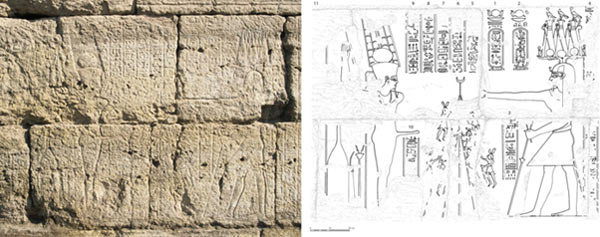Stone Carving Depicts Roman Emperor Claudius Dressed as Egyptian Pharaoh
In 2014, a team of researchers announced the discovery of a stone carving depicting Roman Emperor Claudius dressed as an Egyptian pharaoh and wearing an elaborate crown. The findings of the research, published in the journal Zeitschrift für ägyptische Sprache und Altertumskunde, suggested that the stone carving reflects a ritual that took place in honor of Egyptian fertility god Min.
Claudius was Roman emperor from 41 to 54 AD, ruling at a time in which Egypt was under Roman control. However, according to the study authors, Claudius never visited Egypt. Instead, “his rule over the land at the Nile and the desert regions was legitimized through cultic means," explained Martina Minas-Nerpel, associate professor at Swansea University. "By decorating the exterior temple wall with this ritual, Claudius theoretically received Min's characteristics and thus his ability to rule over Egypt."
The stone carving was discovered on the western exterior wall of the Temple of Isis at Shanhur, 20 kilometers north of Luxor, which dates back to the period of Roman occupation under Augustus (30 BC to 14 AD). It depicts Emperor Claudius erecting a giant pole with a lunar crescent at the top and eight men climbing the supporting poles. Claudius is wearing an elaborate crown consisting of three rushes (plants) set on ram horns with three falcons sitting on top. Three solar discs representing the sun (one for each plant) are shown in front of the rushes.
The accompanying hieroglyphs call Claudius the "Son of Ra, Lord of the Crowns," and say he is "King of Upper and Lower Egypt, Lord of the Two Lands." It explains that Claudius is raising the pole of the cult chapel of Min, god of fertility, and indicates that the ritual took place in summer.
Egyptian priests depicted the Roman emperors as pharaohs up until the fourth century AD. The Roman emperors allowed, or even encouraged, these depictions in Egyptian temples in order to keep Egypt under Roman authority.
The god Min is also depicted in the carving. He is wearing his own crown and is shown with a phallus, possibly a reflection of his status as god of fertility. The hieroglyphs describe Min as "the one who brings into control the warhorses, whose fear is in the Two Lands." Min tells Claudius, "I give you the (southern) foreign lands.” The researchers suggested that this could be a reference to the deserts surrounding the Nile River, where minerals could be quarried.
Top image: A newfound stone carving reveals Roman Emperor Claudius dressed as an Egyptian pharaoh. Source: Marleen De Meyer, line drawing by Troy Sagrillo.



















